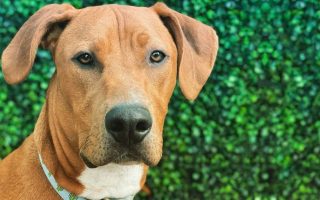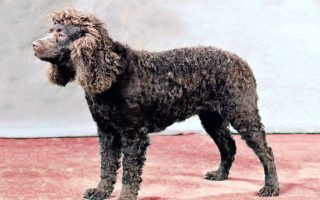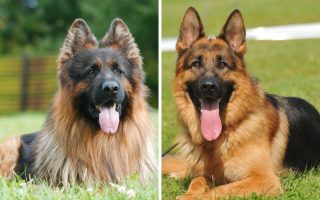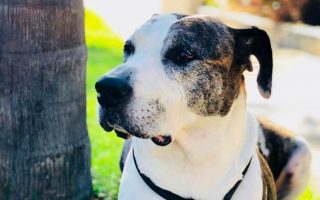Are you wondering if there’s a dog that looks like a fox? Then this ultimate list with pictures is for you.
Dogs and wolves species are known to be close relations, and the former is believed to have evolved by mistake from a friendly variant of the latter.
On the other hand, Foxes are known to belong to the same class as dogs and wolves, known as “Canidae.”
This close relationship between them justifies some similar traits they exhibit.
Dogs are the only ones that humans keep as pets or companions amongst the three aforementioned.
This is because foxes are too dangerous to become household pets or companions.
However, baby foxes are usually admired to be quite adorable and playful. Yet, they’re not to be domesticated as their violent nature is bound to come into play.
So, if you’re one of those that admire foxes, then you may want a fox dog lookalike substitute.
Yes, there are pawfect dogs that look like foxes.
Let’s take you through the list of some of these fox-looking dogs as you may find the right pick for you.
Adorable Dogs That Look Like Foxes
1. Finnish Spitz
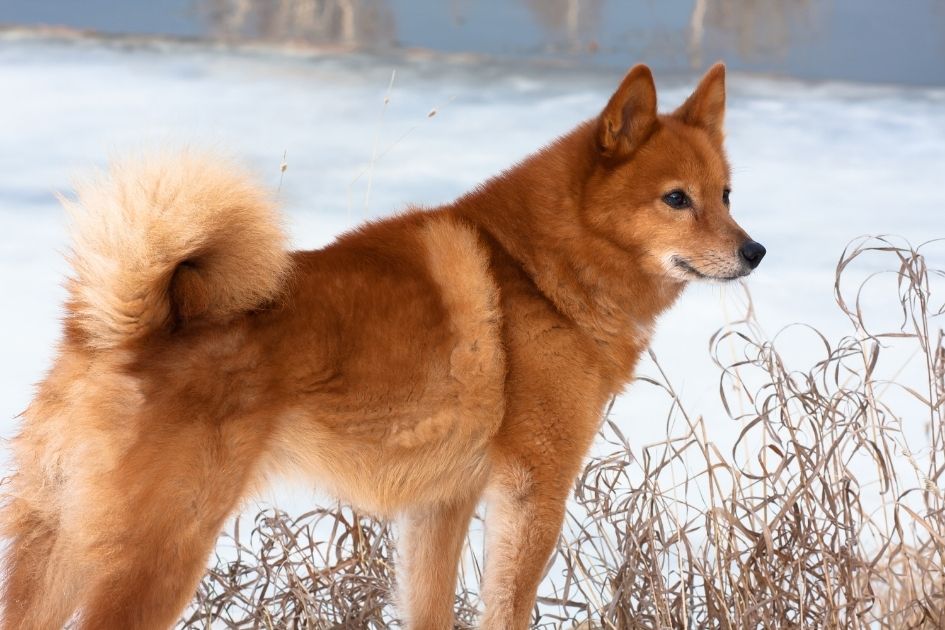
- Lifespan: 12 to 14 years
- Weight: 26 to 29 pounds
- Height: 15 to 20 inches
- Features: Double layered coat, black nose, lips, and eye rims, dewclaws
- Country of Origin: Finland
Finnish Spitz is a medium-sized dog breed initially bred for hunting down games like bears, squirrels, and other rodents.
It uses its bark pointer skills to attract the games to itself for an easy catch by the hunter.
A mere photo is enough to note that the Finnish Spitz is a medium-sized dog that looks like a red fox—from the structure of its face, its ears, its double-layered coat, and even its tail.
It has its history dated back to the spitz type of dog that originated from Russia over 3,000 years back.
Thirty years of continuous breeding gave rise to the existence of the modern-day Finnish Spitz. It is a member of the Finnish Spitz Club of America.
This dog breed is lovable and friendly enough to be around kids, making it convenient for domestic living.
They are always alert and very active, hence they may need long walks daily and indoor playtime to keep their energy level in check.
As friendly as they may seem and act, their barking skill is a skill they inevitably exhibit as it is a part of hunting needs.
This intelligent, devoted breed trains better when treated with a calm tone and touch.
Although a generally healthy breed, the Finnish Spitz is susceptible to health issues like hip and elbow dysplasia and epilepsy.
It is advised that this dog be fed and groomed appropriately to help maintain better health alongside proper regular checkups to help detect any ailment early for treatment.
2. Japanese Shiba Inu
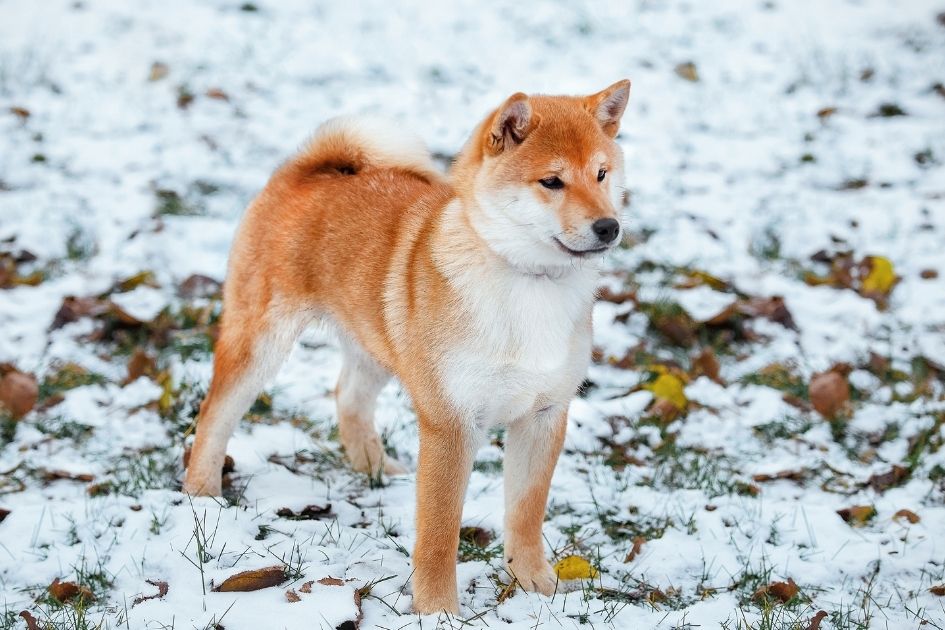
- Lifespan: 13 to 15 years
- Weight: 18 to 22 pounds
- Height: 13 to 17 inches
- Features: Short fur, double layer coat, fox-looking dog face, legs, and ears
- Country of Origin: Japan
The Japanese Shiba is an adorable small dog that looks like a fox. They are bred for hunting down small games like rabbits and birds.
It is pretty similar to the Akita Inu but has a different bloodline, size and characteristics.
Its history traces it back to mountainous regions before crosses between it and other western breeds almost wiped out its pure variation.
This breed is spirited with an independent personality, making it want to keep itself clean by constantly licking its legs and claws.
The Japanese Shiba is also prone to screaming when provoked or made unhappy.
Generally, they are healthy and are expected to live out their life span if properly taken care of.
Grooming this breed is relatively easy as they are usually clean. Daily walks and exercise are also necessary for this breed.
However, we recommended taking them to a vet for joint and eye checks, as they are prone to conditions like hip dysplasia, glaucoma, allergies, and cataract.
3. Korean Jindo
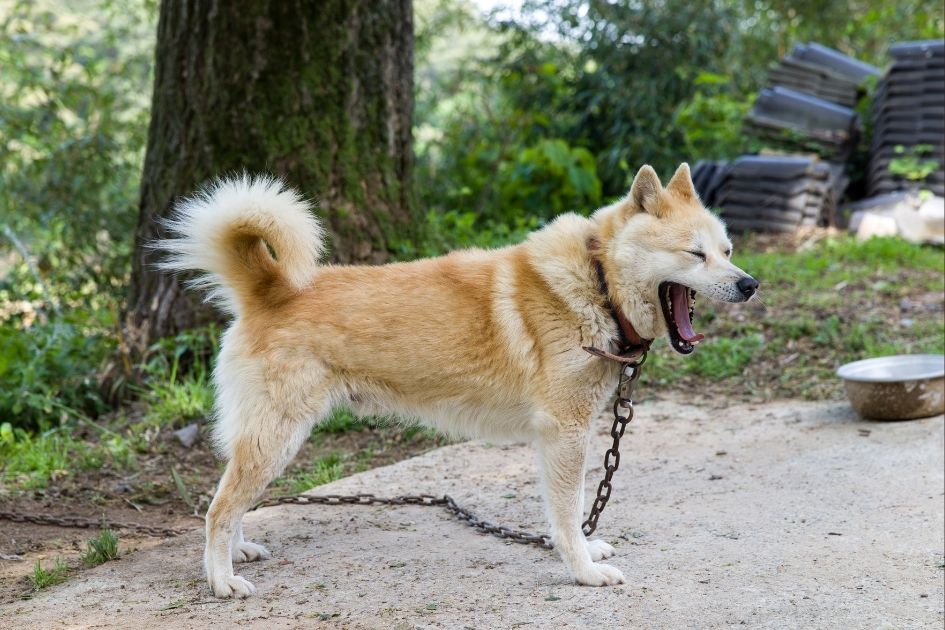
- Lifespan: Up to 15 years
- Weight: 33 to 51 pounds
- Height: 18 to 22inches
- Features: Medium-sized, round feet with tan knee pads, almond eyes, thick hairs
- Country of Origin: South Korea
The Korean Jindo dog breed was known as the South Korean 53rd national treasure under the Japanese regime from 1910–1945.
It was recognized on the 1st of January 1998 by the United Kennel Club.
This dog breed has diverse body types;
- Tonggol, which is more athletic and has a shorter space between its false rib and hip bone;
- Hudu also called Hotgae, which is quite slimmer, has less chest depth and slightly longer space between its false rib and hip bone, and a third variant,
- Gakgol, which is not well known, yet are recognized by the Korean National Dog Association.
Jindo canines possess a loyal and gentle character with their ever-active nature that requires a spacious environment for exercises or other dog-related activities.
This medium-sized intelligent dog has strong legs that allow for high jumps, hence the need for high fencing around the yard they are being kept.
Like every other dog breed, they require care and attention to keep them looking well-groomed and catered for.
4. Canaan Dog
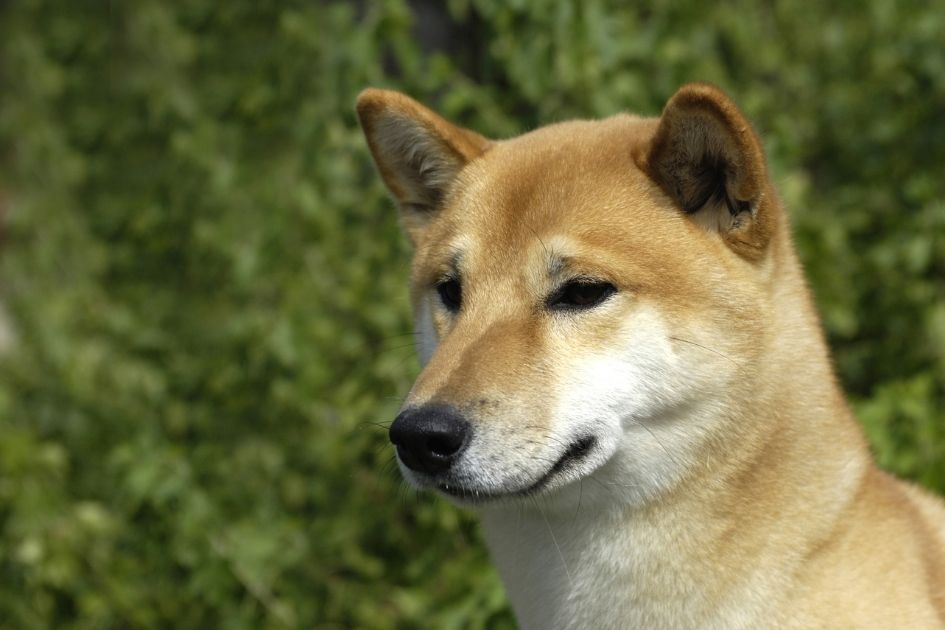
- Lifespan: 12 to 15 years
- Weight: 40 to 54 pounds
- Height: 18 to 24 inches
- Features: Bushy tail, lean body, almond-shaped eyes, erect ears
- Country of Origin: Middle East
The Canaan Dog is a wild dog breed that has had recognition from Canada, Israel, the United Kingdom, and the American Kennel Clubs.
History has it that this breed has been used for guarding camps and herds by the Bedouins.
These medium-sized breeds are not aggressive but can always act out of defense.
They are always alert and can react swiftly due to their mistrust of strangers.
They are skilled enough to compete in obedience, tracking, and herding events due to their excellent herding skills.
The Canaan Dog breed is popular in Israel, Lebanon, Jordan, including Egypt and Syria.
However, they have reduced in population around Israel as most were killed during the government’s attempt to eradicate rabies.
5. Basenji
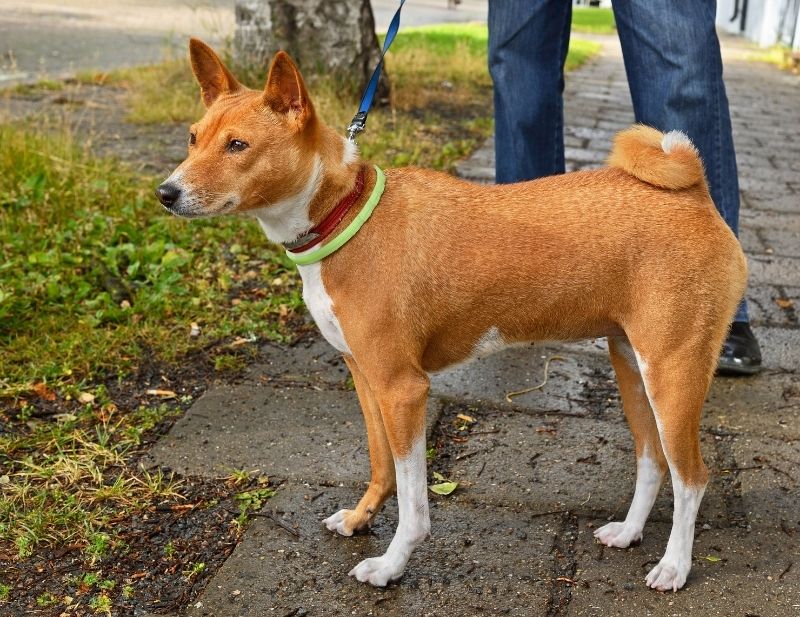
- Lifespan: 14 to 16 years
- Weight: 21 to 24 pounds
- Height: 15 to 17 inches
- Features: Short haired, erect ears, wrinkled forehead, square-shaped body, almond eyes
- Country of Origin: Democratic Republic of Congo
The Basenji breed is cherished in Congo for its pace, quietness, strength, and intelligence.
They are an independent breed often considered intelligent as they can acknowledge activities for which they are fit.
All efforts to get this dog breed into England proved abortive.
These species were detected to be infected up until the year 1930 where a few imports were made successfully after establishing foundation stock in England.
The Basenjis are currently recorded with the United Kennel Club and the American Kennel Club.
A book titled “The Intelligence of Dogs” tagged the Basenji dog as the second most challenging dog breed to train.
Their intelligence is realistic only when actual problems that benefit them need to be solved, like food.
They are prone to various health issues, including infertility, bladder disorder, dermatitis, hypothyroidism, hip dysplasia, etc.
6. Samoyed
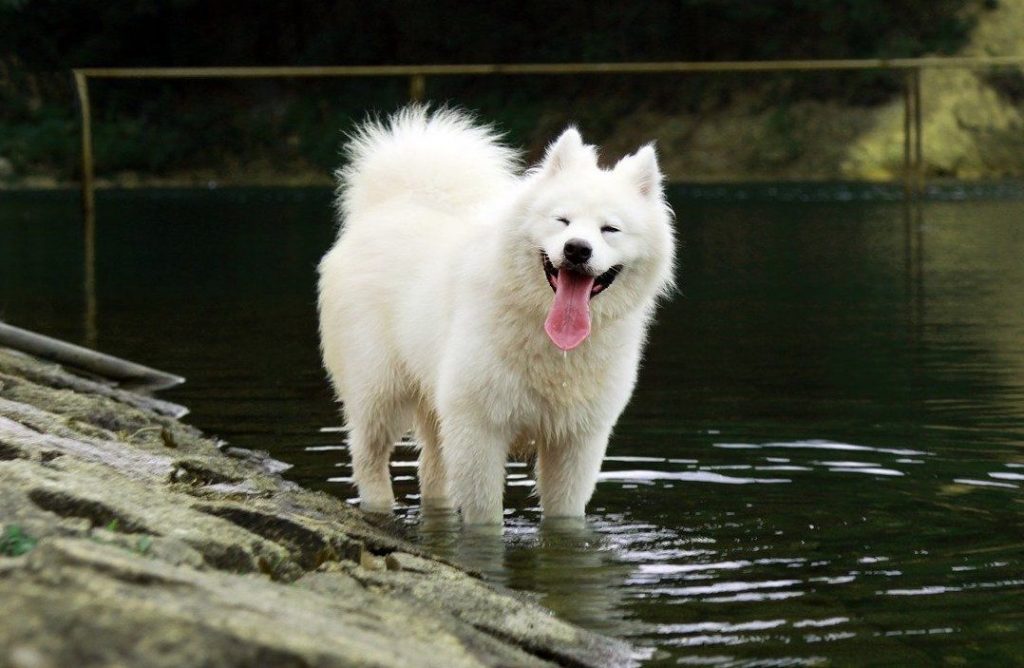
- Lifespan: 12 to 14 years
- Weight: 35 to 66 pounds
- Height: 18 to 22 inches
- Features: Double layered coat, hard triangular ears, black or brown almond eyes
- Country of Origin: Northwest Russia, Western Siberia
Sammy, or Smiley, as nicknamed, is the modern descendant of the basal dog breed often used to herd, hunt reindeers, and tow sleighs for Siberian people.
The fur that it sheds is usually used in place of wool in knitting as both textures are similar.
Sammy is so friendly it makes a terrible guard dog, although they can raise the alarm by barking when something unusual is noticed.
It is almost impossible to see an aggressive Samoyed breed; they always have that happy mood.
This breed is suitable for family living; they are good friends to children, other dogs, and pets and maintain such an attitude until they get old.
However, they display a destructive attitude when they become uninterested.
The Samoyed breed is prone to certain diseases, including a hereditary condition known as Samoyed Hereditary Glomerulopathy.
This disease is more dominant in the male variant of this breed.
7. Indian Spitz
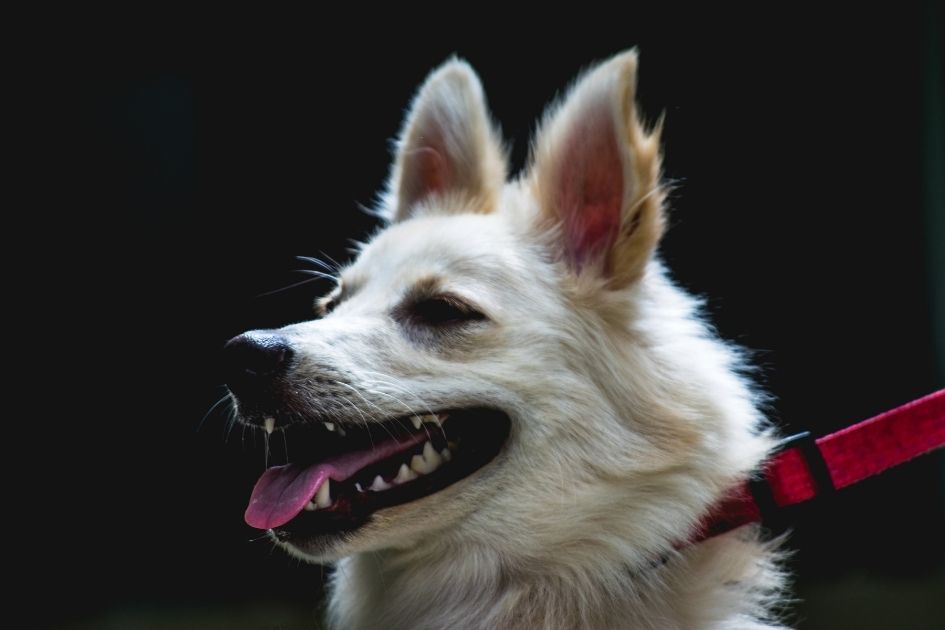
- Lifespan: 12 to 15 years
- Weight: 22 to 44 pounds
- Height: 11 to 16 inches
- Features: Pointed ears, coarse fur, small-sized, pure milk-colored double-layered coat
- Country of Origin: India
The Indian Spitz, which is quite identical to the European breed, is believed to be a descendant of the German Spitz.
Its popularity began around the late 1900s when the Indian government ruled against imports, making this breed the only available option as other species were not easily accessible.
The Indian Spitz is a small dog that looks like a fox, with a facial resemblance, alongside its pointed ears.
It is nicknamed the Indian pomeranian due to certain similarities it shares with the pomeranian dog breed.
However, there are slight differences in its size, which is slightly bigger, and its shorter coat.
This breed is intelligent and enjoys being around its human family but does not do well around other dogs and pets.
Although not recognized by any major kennel club globally, the Kennel Club of India acknowledges them as a distinct Indian dog breed.
India Spitz requires to be groomed regularly, fed appropriately, and cared for like other pet dogs.
They are generally active, healthy, and can conveniently withstand harsh weather conditions.
8. Alaskan Klee Kai
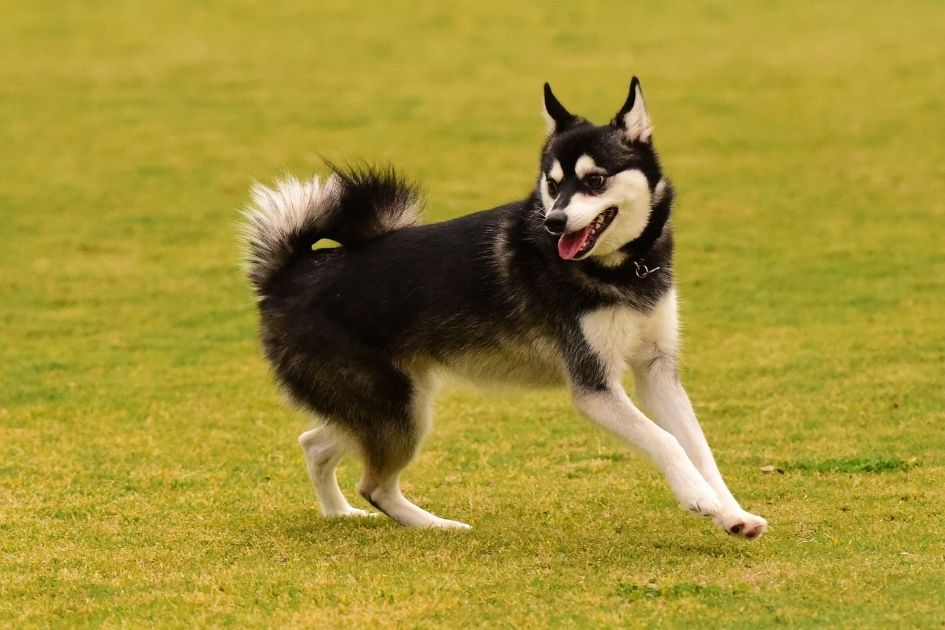
- Lifespan: 12 to 16 years
- Weight: 16 to 22 pounds
- Height: 15 to 17 inches
- Features: Small-sized, upright ear, thick coat
- Country of Origin: United States
The Alaskan Klee Kai is a small dog created in Alaska by Linda Spurlin around the 1970s using the American Eskimo, Alaskan Husky, Siberian Husky, and a small amount of Schipperkes.
The breed is intelligently stubborn, very active but not so friendly.
They may be small but are good at high jumps due to their strong bones and are easy to get around during skill training.
Klee Kai comes in three distinct sizes; toy, miniature, and the standard breed size.
The toy variant weighs the least and is only about 13 inches tall; the miniature can be 13 inches tall or more with a weight ranging from 10 to 15 pounds, and the standard breed can weigh up to 22 pounds with a height reaching 17 inches.
They are relatively healthy breeds but prone to conditions like liver diseases, cataracts, heart problems, and thyroid issues.
9. Volpino Italiano

- Lifespan: 14 to 16 years
- Weight: 9 to 12 pounds
- Height: 9 to 12 inches
- Features: Small size, long coat
- Country of Origin: Italy
Volpino Italiano breed has existed since the 19th century, and the Kennel Club Italiano brought out the first standard in 1913.
In 1956, it was recognized by the Federation Cynologique Internationale and later recorded threats to completely being extinct in 1960.
The current century has recorded an average of 160 new registrations per annum.
The champagne color of this small-sized breed is known to be the internationally recognized color, although there exists the white and deep red color.
It is among the rare breeds that have been recorded to experience painful eye defects that can result in blindness. It has a striking facial appearance like the Arctic fox.
10. American Eskimo Dog
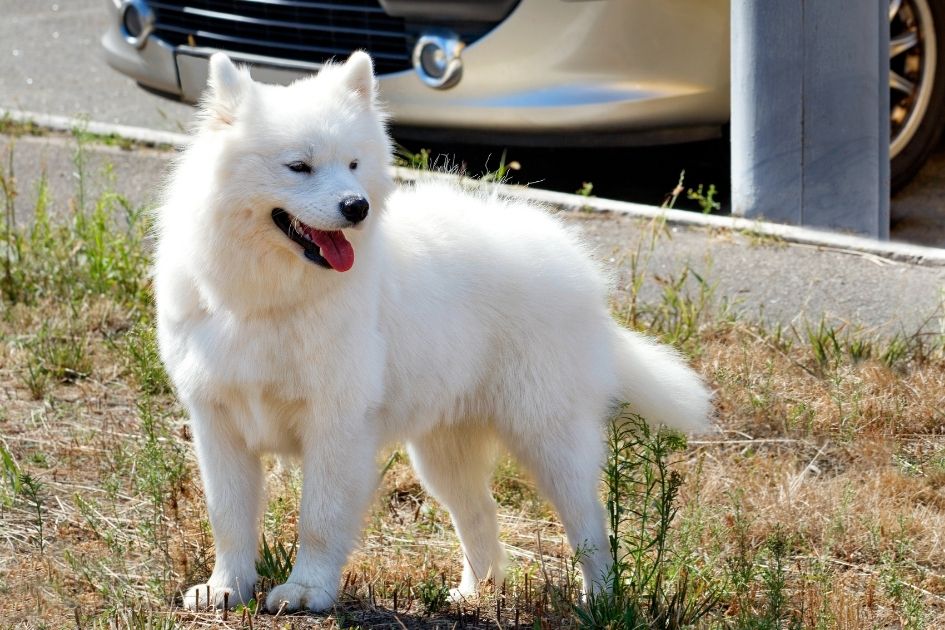
- Lifespan: 13 to 15 years
- Weight: 18 to 36 pounds
- Height: 14 to 21 inches
- Features: Small size, fox-like ears, black lips, and nose
- Country of Origin: Germany, United States
Also known as Eskie, the American Eskimo Dog was recognized by the Canadian Kennel Club in 2006.
Years later, it was accepted into the American Kennel Club in 1995. It’s a descendant of some famous American circus dogs, including the Spitz breed.
These cute dog breeds are considered credible and devoted companion pups, and they go well with kids.
Like other domestic dogs, they are intelligent, always alert, lovable, and very protective.
Eskie requires regular grooming and mild exercise to keep them in shape.
Your dog’s diet is also essential to pay much attention to as this will determine how healthy they may turn out.
11. Long-Haired Chihuahua
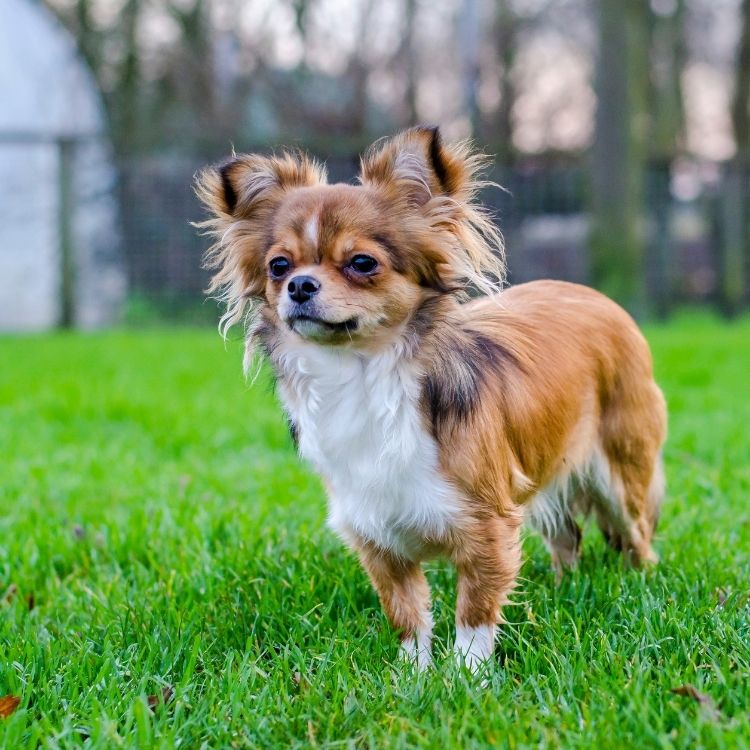
- Lifespan: 15 to 20 years
- Weight: 3 to 6 pounds
- Height: 5 to 9 inches
- Features: Small size, long coat
- Country of Origin: Mexico
Originally bred as a popular meal in the 15th century and also to hunt rodents, The toy breed is one of the smallest dogs in the world.
They were named after the state Chihuahua in Mexico city, and their history can be traced back to their ancestors, the Techichi breed from thousands of years back.
They exist in two types; the AKC has accepted the apple and the deer head as a toy breed.
They are lap dogs with a loving and devoted nature, always protective of their human companion.
The Long-haired Chihuahua does well with adults as their small size is too delicate for kids to handle, but they also get to enjoy playing with kids.
Early training and socialization can help this pup get acquainted with other dogs and pets and reduce their level of aggression and barking.
When sorting out their diet, it is necessary to split their meals into three or four smaller portions daily, rather than one heavy meal.
Avoid meals with high sodium content in order not to get your little pup sick with dehydration.
Playing games and taking walks on a daily basis is enough to get your Long haired Chi fully exercised.
It is also important to note that their small nature doesn’t exempt them from being stubborn and may need to be trained well enough to know their place in the home.
Regular checkup is recommended as well to keep the health of your little canine in check.
They may be prone to some ailments like low blood sugar, patella luxation, and heart issues.
12. Icelandic Sheepdog
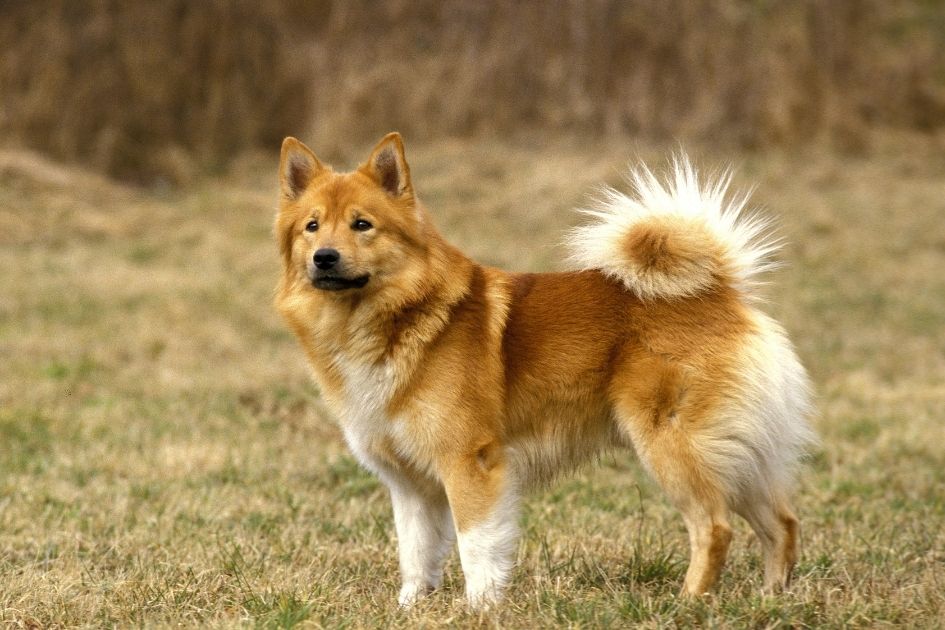
- Lifespan: Typically 12 years
- Weight: 23 to 30 pounds
- Height: 17 to 18 inches
- Features: Triangle shaped ear, red hair
- Country of Origin: Iceland
Icelandic Sheepdog is a spitz-type dog used to herd sheep in the Iceland region from when they were brought into the nation by Vikings.
This dog breed that looks like a fox gained AKC recognition in June 2010.
Iceland dog is slightly below the medium-sized dog breeds known to be strong and very active.
They are neither used as hunting dogs or human guarding dogs as they have a friendly attitude towards strangers. Their job is focused on herding and finding lost sheep.
These dogs have a very jovial nature that makes them good and playful around children, other dogs, and pets.
They are easy to train and may require sufficient exercise that matches their activeness.
Icelandic sheepdogs require grooming, and a proper diet that keeps them fueled and healthy.
13. Pembroke Welsh Corgi
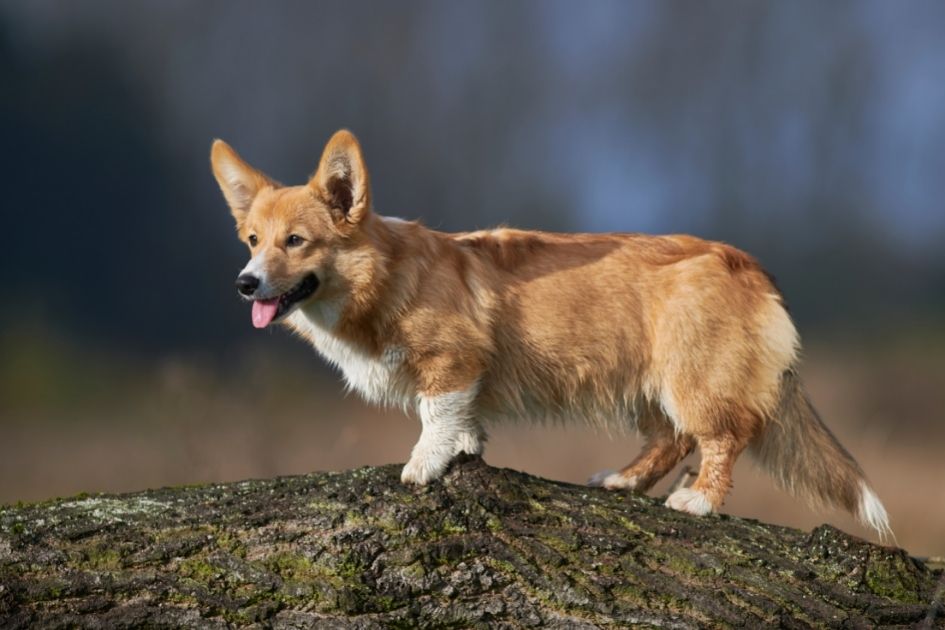
- Lifespan: 12 to 15 years
- Weight: 24 to 31 pounds
- Height: 10 to 12 inches
- Features: Dwarf legs, triangle ears, fox-like head
- Country of Origin: Wales
The existence of this dwarf dog is backed up by the story of two kids who got two small pup gifts from a fairy during a forest funeral they stumbled upon at playtime.
The kids took the pups home and from them, the Pembroke breed became popular.
On the other hand, it is speculated that this breed was brought to wale by Flemish immigrants.
This breed first appeared under the Britain Kennel Club in 1925 followed shortly by the opening of the Corgi club.
They became quite famous in the United States, ranking 20th on the American Kennel Club list of most popular dogs as of 2015.
The Pembroke pup has appeared in several American television shows and Netflix series titled “The Crown.”
It has been portrayed over time as a very loyal and intelligent dog breed.
They are known to possess herding instincts as they were originally used to herd cattle.
Welsh pups are easy to train and have friendly interactions with kids, other dogs, and pets.
They fit well into any kind of living, be it an apartment setting or a large terrain setting.
15. Dhole
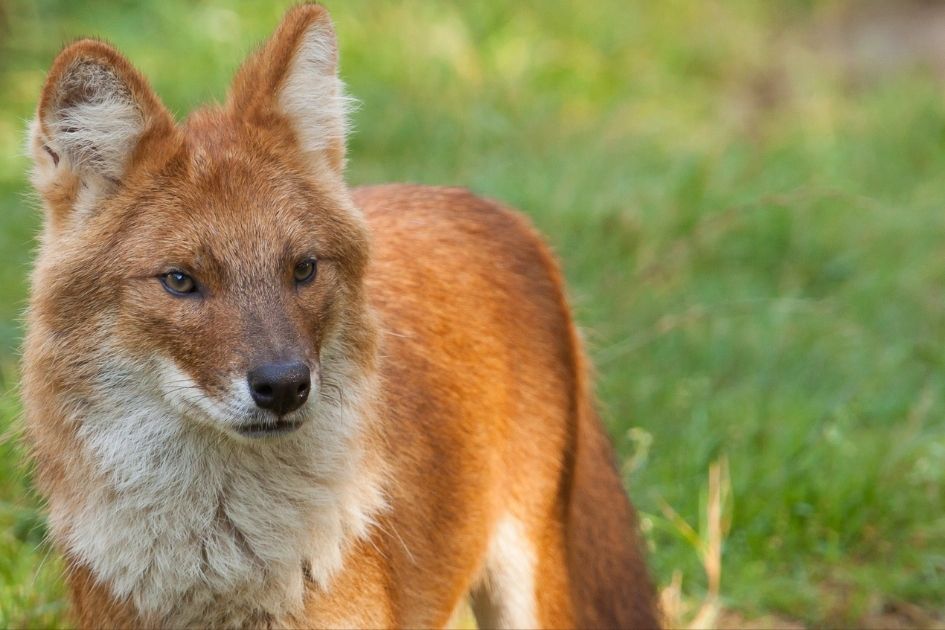
- Lifespan: 15 to 16 years
- Weight: 22 to 46 pounds
- Height: 16 to 22 inches
- Features: Lengthy backbone, slim legs, huge skullcap
- Country of Origin: Asia
Dhole is a medium-sized canine also known as the Asian wild dog that resembles a red fox or a wolf.
It has been classified as a wild dog currently endangered, having less than 2,500 of its kind globally.
The fun fact is that the Dhole is sociable, with a hunting skill that has recorded attacks on large animals like tigers and bears.
However, they seldomly display any form of aggressive behavior.
They have been reported to have existed in the eastern and southeastern parts of Asia, North America, Europe, etc.
They exist in certain kinds of habitats, which include; Jungle, mountains, forests, whether dense or scrub, etc.
This breed is carnivorous and usually hunt for prey in pack, and can eat more than a kilogram of meat in the space of four to five seconds.
Dhole’s reduction in numbers isn’t a result of being prey to other animals. They have been food for tigers just as they have killed tigers, but the major challenge has been due to loss of habitat.
Deforestation for human use has affected the breed’s ability to hunt for prey, causing too much competition between them and other wild animals as well.
15. Kugsha
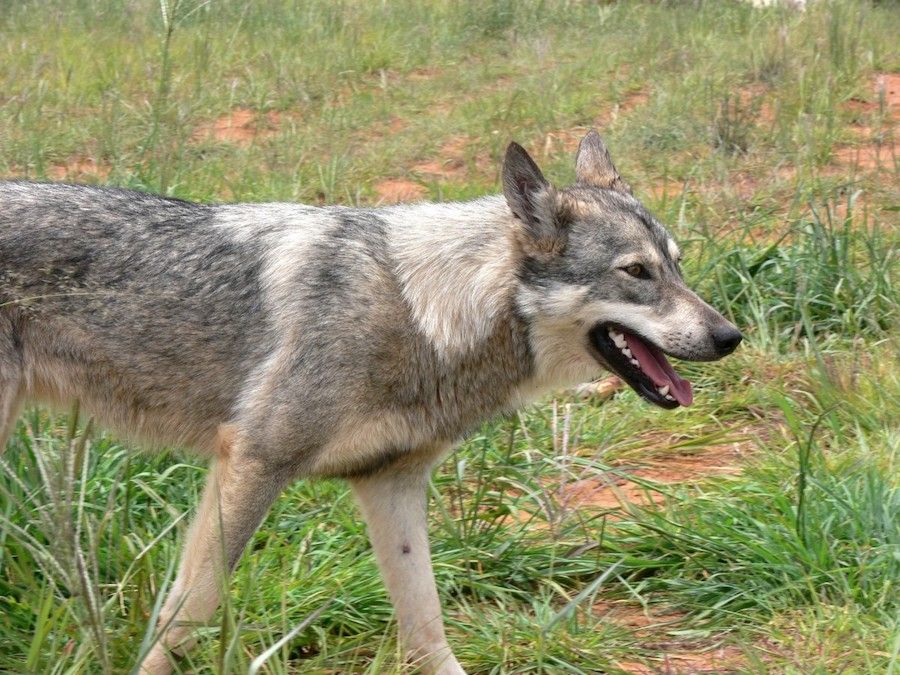
- Lifespan: 14 to 16 years
- Weight: 75 to 85 pounds
- Height: 23 to 25 inches
- Features: Smooth double-layered coat, erect ear, long legs
- Country of Origin: United States
This breed undeniably has a striking resemblance to the wolf and is believed to have a genetic relationship with it.
It is a rare breed used as watchdogs and is a very intelligent dog that may require early training due to its primitive attitude.
Also known as American Husky or Amerindian Malamute, Kugsha is not quite suited for apartment living.
However, they can bond well with family members and enjoy the attention they give to it.
Their high prey instinct makes them not safe enough to be around kids but can do well with other dogs and pets.
It is an active breed that requires a large space for intense exercise, but such an ample space needs to be enclosed as they can easily stray off in search of prey.
Early socialization of your Kugsha can keep away the bad habits of being destructive or disobedient.
Also, healthy dry meals can help keep your pup fueled up and healthy. Grooming for this dog is also very necessary and should not be taken for granted.
Frequently Asked Questions
What is a fox dog called?
Fox dogs are also known as Tox Terriers traditionally used to hunt foxes out of their hiding places but have become companion pups.
Is a fox a dog breed?
Foxes and dogs belong to the Canidae species but are completely two different animals.
Do foxes bark?
Yes, foxes bark similarly as dogs only at a little increased tone. They usually do this as a signal of communication to reach out to friends or foes.
Are foxes good pets?
Foxes are not ideally good pets as they are wild animals yet to be domesticated. They cannot live well as household pets and it is illegal in most countries to own one.
Final Thoughts
These are some of the dogs that look like foxes. That they are fox looking dogs does not make them one breed and should not be treated as such.
If you have always admired the appearances of foxes but are too frightened to get close to them due to how wild they may be, it wouldn’t be a bad idea to substitute with one of the dogs listed above.
They may be able to fill up the space in you that is interested in foxes. Who knows?


